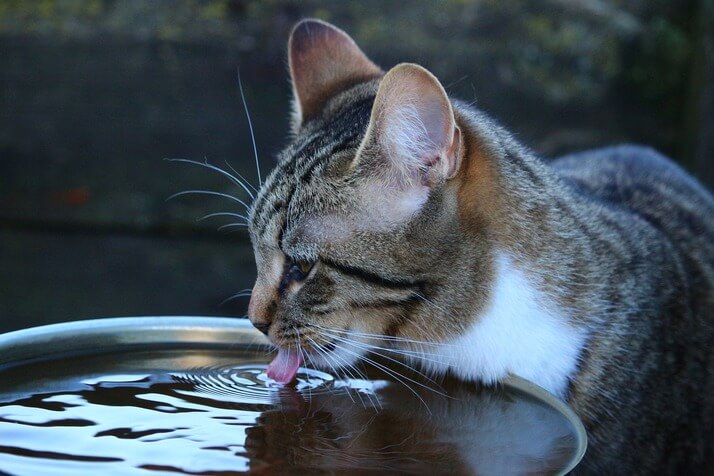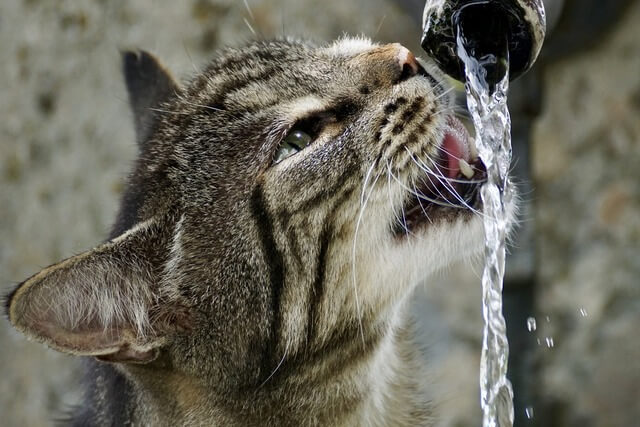
Your feline friend needs at least one ounce of water per pound of body weight each day to stay healthy. But if your cat is like most cats, then it’s probably not absorbing enough water from its regular meals.
If getting your cat to drink more water is becoming a challenge, there are a few tricks you can employ to get it rehydrated.
There is no single solution to make a cat drink more, but there are many tips and tricks you can use to get them to drink more water.
We’ll go over specific tricks for getting your cat to drink more, provide helpful reasons why cats don’t drink enough and look at the consequences of not getting your cat to hydrate properly.
In this guide, I’ll give you 4 useful tips to help increase your cat’s water intake so that it remains healthy and hydrated throughout the day.
How much water is a cat supposed to drink?
According to the Committee on Nutrient Requirements of Dogs and Cats, cats typically consume an ounce of water for every half-ounce of dry food that they eat.
Veterinary professionals suggest that healthy cats should drink around ½ cup of water per 5 lbs of bodyweight daily.
The amount of water cats need varies based on their diet and any existing medical issues.
Though you can determine the exact amount of water put in the bowl each day, bear in mind that cats consume other sources of water too; for example, wet/canned food, faucets, or other pet bowls in the house.
Is it an emergency if my cat does not drink enough water?

If not drinking enough water continues for an extended time, dehydration can happen, which can lead to severe and even deadly outcomes.
Sadly, pet owners don’t often catch signs of dehydration in cats until it gets really bad.
Signs of dehydration include:
Dry Gums: For dry gums, gently press your finger into the cat’s gums. If the gums eventually turn back to the normal pink color, it is a good sign.
This should occur in a span of under two seconds. Signs of dehydration include cherry-red gums, the gums sticking to your finger after pressing on them, or more than two seconds of refill time.
Sunken eyes: With moderate to severe dehydration, your cat’s eyes will appear sunken into their head.
Vomiting/Diarrhea: Constant vomiting and diarrhea remove a lot of water from the body, making it hard for cats to stay hydrated.
One episode of vomiting or diarrhea likely is not a cause for concern regarding dehydration, but if these symptoms are accompanied by other signs or become recurrent, dehydration will take place.
These clinical signs can indicate dehydration, so it’s essential to reach out to your veterinarian immediately and discuss the symptoms.
4 essential tips to get your cat to drink more water
Cats aren’t known for their love of drinking water, but it’s still important for them to stay properly hydrated.
If you’ve noticed that your cat isn’t drinking enough water, then you may be concerned about the potential health risks of dehydration.
Fortunately, there are ways to entice your cat to drink more. In this article I’ll discuss 4 essential tips that you can use to get your cat to drink more water and keep them healthy and hydrated.
So without further ado, let’s dive in!
Get your cat to eat wet food
If your cat already enjoys and eats wet food, you will be happy to know that it is an excellent source of hydration for cats.
For cats already on wet food, if they need to drink more water, try adding a bit extra to the food.
If your cat won’t eat the food with water added, don’t attempt to make them eat it as this could result in the cat forming a dislike for that food or, even worse, go on a hunger strike!
If your cat only consumes dry food, consult with your veterinarian to figure out which wet food is the best option for their nutritional needs.
Introducing wet food to their diet gradually is a good idea. It is essential to offer cats different flavors and textures, as they can be quite choosy about what they eat.
Some cats will only consume paté, while others constrain themselves to chunks in gravy or loaf-style textures.
Test different bowls
Some kitties are choosy with their water bowl, so I suggest either a stainless steel or ceramic one.
If the water dish is too small and shallow, it can bother your four-legged buddy’s whiskers and create a sensory overload every time they try to drink from it.
Keep in mind that your cat likely wouldn’t like using the same, big bowl as your dog. The only way to truly understand what your cat prefers is to switch their bowls around.
It would be even better if you keep multiple bowls out at the same time and observe which one empties out faster.
Add flavor to the water
Mix in a small amount of tuna, salmon, or clam juice (which should be from spring water, not brine) to their drinking water.
Begin with ¼ teaspoon per bowl and gradually increase the dosage until you determine what works best for your cat.
To make sure your average-sized cat is healthy, don’t let them consume more than a teaspoon of clam juice per day; this is especially important if they have any heart or kidney issues.
Low-sodium chicken broth (without onion or garlic) is also an option.
For best results, make sure to dissolve the powder well in warm water before giving it to your cat. Keeping it overnight and shaking it up will also help ensure that everything is dissolved properly before you give it to your cat.
Try different types of water
We’re not talking about sparkling water vs. still water – we’re referring to what’s inside the water instead.
Even though fluoride is added to our drinking water to prevent tooth decay and gum disease, your furry feline friend may not like the taste of it.
You can try giving your cat fluoride-free bottled water or use a water filter that may enhance the flavor of tap water, but won’t remove fluoride.
Likewise, experiment with different temperatures. Most cats prefer drinking lukewarm water, but some might like it cold.
Conclusions
In conclusion, while cats naturally prefer to get most of their hydration from food, it is still important that they drink plenty of water.
By following the steps outlined above and making sure that there is always a supply of fresh, clean water available for your cat, you can help ensure that it stays healthy.
Remember that in addition to these tips, keeping your cat’s environment clean and stress-free will also go a long way towards promoting their overall wellness.
So don’t be afraid to spoil your kitty with lots of pets and cuddles too – after all, we all need a little TLC once in a while!